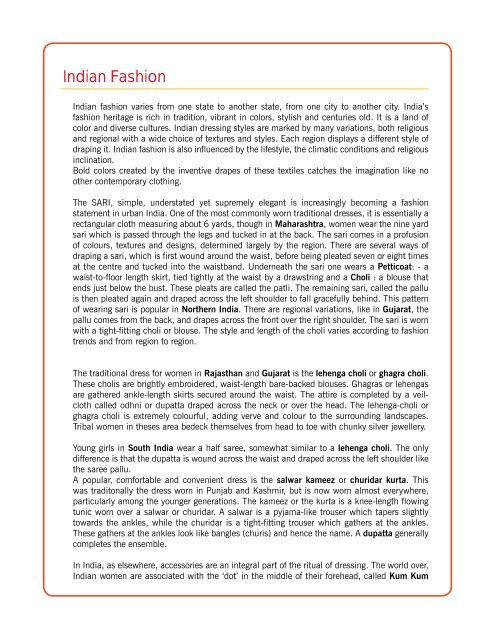IAM - Folklorama Magazine 2008 - Indian Association of Manitoba
IAM - Folklorama Magazine 2008 - Indian Association of Manitoba
IAM - Folklorama Magazine 2008 - Indian Association of Manitoba
You also want an ePaper? Increase the reach of your titles
YUMPU automatically turns print PDFs into web optimized ePapers that Google loves.
<strong>Indian</strong> Fashion<br />
<strong>Indian</strong> fashion varies from one state to another state, from one city to another city. India’s<br />
fashion heritage is rich in tradition, vibrant in colors, stylish and centuries old. It is a land <strong>of</strong><br />
color and diverse cultures. <strong>Indian</strong> dressing styles are marked by many variations, both religious<br />
and regional with a wide choice <strong>of</strong> textures and styles. Each region displays a different style <strong>of</strong><br />
draping it. <strong>Indian</strong> fashion is also influenced by the lifestyle, the climatic conditions and religious<br />
inclination.<br />
Bold colors created by the inventive drapes <strong>of</strong> these textiles catches the imagination like no<br />
other contemporary clothing.<br />
The SARI, simple, understated yet supremely elegant is increasingly becoming a fashion<br />
statement in urban India. One <strong>of</strong> the most commonly worn traditional dresses, it is essentially a<br />
rectangular cloth measuring about 6 yards, though in Maharashtra, women wear the nine yard<br />
sari which is passed through the legs and tucked in at the back. The sari comes in a pr<strong>of</strong>usion<br />
<strong>of</strong> colours, textures and designs, determined largely by the region. There are several ways <strong>of</strong><br />
draping a sari, which is first wound around the waist, before being pleated seven or eight times<br />
at the centre and tucked into the waistband. Underneath the sari one wears a Petticoat: - a<br />
waist-to-floor length skirt, tied tightly at the waist by a drawstring and a Choli : a blouse that<br />
ends just below the bust. These pleats are called the patli. The remaining sari, called the pallu<br />
is then pleated again and draped across the left shoulder to fall gracefully behind. This pattern<br />
<strong>of</strong> wearing sari is popular in Northern India. There are regional variations, like in Gujarat, the<br />
pallu comes from the back, and drapes across the front over the right shoulder. The sari is worn<br />
with a tight-fitting choli or blouse. The style and length <strong>of</strong> the choli varies according to fashion<br />
trends and from region to region.<br />
The traditional dress for women in Rajasthan and Gujarat is the lehenga choli or ghagra choli.<br />
These cholis are brightly embroidered, waist-length bare-backed blouses. Ghagras or lehengas<br />
are gathered ankle-length skirts secured around the waist. The attire is completed by a veilcloth<br />
called odhni or dupatta draped across the neck or over the head. The lehenga-choli or<br />
ghagra choli is extremely colourful, adding verve and colour to the surrounding landscapes.<br />
Tribal women in theses area bedeck themselves from head to toe with chunky silver jewellery.<br />
Young girls in South India wear a half saree, somewhat similar to a lehenga choli. The only<br />
difference is that the dupatta is wound across the waist and draped across the left shoulder like<br />
the saree pallu.<br />
A popular, comfortable and convenient dress is the salwar kameez or churidar kurta. This<br />
was traditonally the dress worn in Punjab and Kashmir, but is now worn almost everywhere,<br />
particularly among the younger generations. The kameez or the kurta is a knee-length flowing<br />
tunic worn over a salwar or churidar. A salwar is a pyjama-like trouser which tapers slightly<br />
towards the ankles, while the churidar is a tight-fitting trouser which gathers at the ankles.<br />
These gathers at the ankles look like bangles (churis) and hence the name. A dupatta generally<br />
completes the ensemble.<br />
In India, as elsewhere, accessories are an integral part <strong>of</strong> the ritual <strong>of</strong> dressing. The world over,<br />
<strong>Indian</strong> women are associated with the ‘dot’ in the middle <strong>of</strong> their forehead, called Kum Kum


